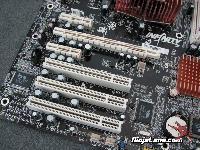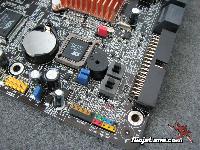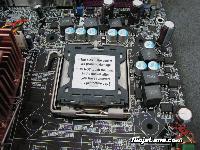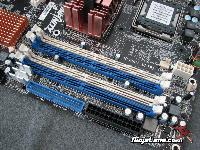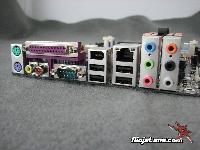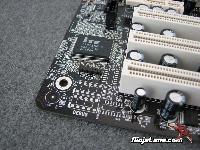After careful consideration I have decided to transfer all hardware review activities to a new domain. I purchased Hardwareasylum.com in 2012 and have been working hard to build a new and improved Ninjalane on that domain. If you are reading this you have reached one of the archived articles, news, projects and/or reviews that were left behind during the site migration.
Please update your bookmarks and be sure to visit the new and improved Ninjalane at Hardwareasylum.com
DFI Infinity NF650i "Dark" Motherboard Review
Author: Dennis Garcia
Published: Thursday, July 12, 2007
Board Layout and Features
One of the first things we look at on any new motherboard is the overall layout of components and cooling.
The photos indicate a typical PCI Express layout with a single 16x video slot between 2 smaller 1x slots. Below you'll find 3 standard PCI slots for increased expandability. One of the key LAN Party centric features are the onboard power and reset switches. We find these to be very convent for testing it would seem the designers at DFI feel they are a great value to the consumer as well.
Front panel connectors are color coded and if you need to reset the CMOS you'll find the jumper nearby.
The photos indicate a typical PCI Express layout with a single 16x video slot between 2 smaller 1x slots. Below you'll find 3 standard PCI slots for increased expandability. One of the key LAN Party centric features are the onboard power and reset switches. We find these to be very convent for testing it would seem the designers at DFI feel they are a great value to the consumer as well.
Front panel connectors are color coded and if you need to reset the CMOS you'll find the jumper nearby.
At the top of the motherboard you will find a single 775 LGA processor socket with support for all major 775 Intel processors with FSB speeds ranging between 800 and 1333Mhz (and beyond with overclocking). A keen eye will also notice the 6 phase analog power supply using solid state caps and coils. While this isn't digital the components are very well made and designed for smooth power delivery.
4 DDR2 memory slots are found nearby with support for a maximum of 8GB of DDR2 800 memory. The memory clock does go faster for those of you planning to do some overclocking. During our tests we manually set the memory clock to be 1:1 with the processor FSB, even after 2 days of tests the system was still running strong without a single complaint.
The ATX connector is self explanatory and indicates support for a single gigabit Ethernet, Firewire, 8 Channel audio including digital, 4 USB 2.0 ports, printer and serial. In a way this is nice to see as many mobo makers are trying desperately to ditch the legacy items.
The ATX connector is self explanatory and indicates support for a single gigabit Ethernet, Firewire, 8 Channel audio including digital, 4 USB 2.0 ports, printer and serial. In a way this is nice to see as many mobo makers are trying desperately to ditch the legacy items.
The last item of interest is this silk-screened placeholder for a BIOS POST debugger. While we personally feel this was a good move on the part of DFI there are some that really like to see what the motherboard is doing during POST
On a side note It will be nice when POST debuggers become more than just 2 digit codes and something the user can truly interact with.
On a side note It will be nice when POST debuggers become more than just 2 digit codes and something the user can truly interact with.

